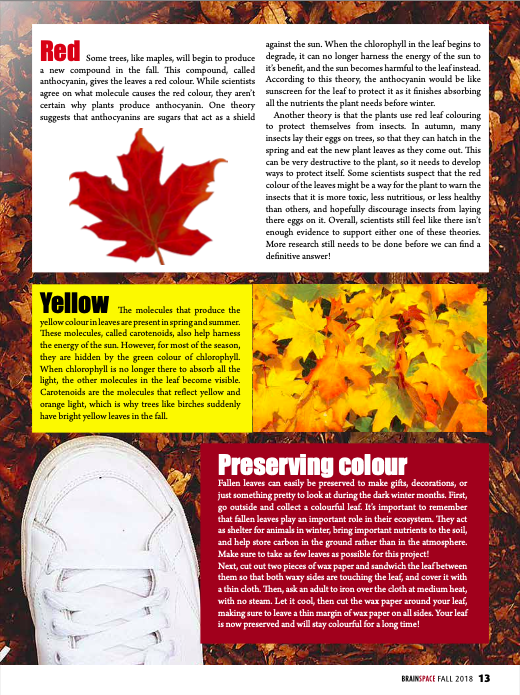
The Mysteries of Autumn Leaves


Have you ever admired the beautiful coloured leaves on autumn trees and wondered why they look the way they do?
Well, you would not be the first! This question has been on scientists’ minds for decades, and they still don’t have a complete answer! Here’s what we know so far about the colours of leaves in fall.
GREEN
Chlorophyll is the part of a leaf’s cell that allows it to make energy from the rays of the sun. Chlorophyll absorbs all colours of light except for green, which it reflects. This is why leaves appear green to us in the summer. But in winter, plants go into dormancy and drop their leaves, so they do not need chlorophyll anymore. In the fall, plants will let their chlorophyll decompose back into smaller molecules, some of which they store for reuse later.
RED
Some trees, like maples, will begin to produce a new compound in the fall. This compound, called anthocyanin, gives the leaves a red colour. While scientists agree on what molecules the red colour, they aren’t certain why plants produce anthocyanin. One theory suggests that anthocyanins are sugars that act as a shield against the sun. When the chlorophyll in the leaf begins to degrade, it can no longer harness the energy of the sun to it’s benefit, and the sun becomes harmful to the leaf instead. According to this theory, the anthocyanin would be like sunscreen for the leaf to protect it as it finishes absorbing all the nutrients the plants need before winter.
Another theory is that the plants use red leaf colouring to protect themselves from insects. In autumn, many insects lay their eggs on trees, so that they can hatch in the spring and eat the new plant leaves as they come out. This can be very destructive to the plant, so it needs to develop ways to protect itself. Some scientists suspect that the red colour of the leaves might be a way for the plant to warn the insects that it is more toxic, less nutritious, or less healthy than others, and hopefully discourage insects from laying their eggs on it. Overall, scientists still feel like there isn’t enough evidence to support either one of these theories. More research still needs to be done before we can find a definitive answer!
YELLOW
The molecules that produce the yellow colour in leaves are present in spring and summer. These molecules, called carotenoids, also help harness the energy of the sun. However, for most of the season, they are hidden by the green colour of chlorophyll. When chlorophyll is no longer there to absorb all the light, the other molecules in the leaf become visible. Carotenoids are the molecules that reflect yellow and orange light, which is why trees like birches suddenly have bright yellow leaves in the fall.
PRESERVING COLOUR
Fallen leaves can easily be preserved to make gifts, decorations, or just something pretty to look at during the dark winter months. First, go outside and collect a colourful leaf. It’s important to remember that fallen leaves play an important role in their ecosystem. They act as shelter for animals in winter, bring important nutrients to the soil, and help store carbon in the ground rather than in the atmosphere. Make sure to take as few leaves as possible for this project!
Next, cut out two pieces of wax paper and sandwich the leaf between them so that both waxy sides are touching the leaf, and cover it with a thin cloth. Then, ask an adult to iron over the cloth at medium heat, with no steam. Let it cool, then cut the wax paper around your leaf, making sure to leave a thin margin of wax paper on all sides. Your leaf is now preserved and will stay colourful for a long time!
